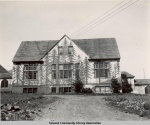Difference between revisions of "Portal:Featured Article Of The Week"
M-Explorer (talk | contribs) |
M-Explorer (talk | contribs) |
||
| Line 1: | Line 1: | ||
{{FAformat | {{FAformat | ||
| − | |Title= | + | |Title= Jesse Lee Home |
| − | |Image= | + | |Image= Balto.jpg |
|Width= 150px | |Width= 150px | ||
| − | |Body= | + | |Body= The Jesse Lee Home, begun by the Methodist Church, had its beginnings as an orphanage in Alaska in 1890. In 1925, the home was moved to Seward, where it eventually grew to several buildings on a 100-acre site. The home offered housing, education, and health care to resident children until 1964 when it sustained severe damage in the Good Friday Earthquake. Goode Hall, one of the original dormitories, was demolished after the earthquake due to extensive damage. |
| − | + | Many Alaska Native children lived in the home, often sent there as a result of the ravages of epidemics of influenza and tuberculosis that hit villages for years throughout Alaska. Among its more famous residents were Benny Benson, designer of Alaska’s flag; Peter Gordon Gould, founder of Alaska Methodist University; and Simeon Oliver, pianist, composer, and writer. Another former resident, James Lewis Simpson, said he arrived at the home in 1929 when he was four years old. He remained there until he graduated from high school at age 17. | |
| + | |||
| + | Simpson, who is Ahtna Athabascan, spent his earliest years in Chickaloon, his mother’s home. When his family ran into difficulties and was not able to care for him, he was put on the train in Anchorage and sent to the home in Seward. He doesn’t recall being frightened when he arrived late in the day, but rather very amazed and curious about his new surroundings. He said he amazed his caregivers to nearly the same degree when he told them he needed to say his prayers before getting into bed. | ||
| + | |||
| + | Simpson declines to analyze the type of care he got at the home, but simply suggests that his service in World War II, followed by the attainment of a bachelor’s degree and teaching certificate and eventually master’s and doctorate degrees speak for themselves. After a successful teaching career in Alaska, he and his wife retired to Oregon. [[Jesse Lee Home|Click here for more...]] | ||
}} | }} | ||
Revision as of 04:18, 17 March 2014
Featured Article Of The Week
Jesse Lee Home
The Jesse Lee Home, begun by the Methodist Church, had its beginnings as an orphanage in Alaska in 1890. In 1925, the home was moved to Seward, where it eventually grew to several buildings on a 100-acre site. The home offered housing, education, and health care to resident children until 1964 when it sustained severe damage in the Good Friday Earthquake. Goode Hall, one of the original dormitories, was demolished after the earthquake due to extensive damage.
Many Alaska Native children lived in the home, often sent there as a result of the ravages of epidemics of influenza and tuberculosis that hit villages for years throughout Alaska. Among its more famous residents were Benny Benson, designer of Alaska’s flag; Peter Gordon Gould, founder of Alaska Methodist University; and Simeon Oliver, pianist, composer, and writer. Another former resident, James Lewis Simpson, said he arrived at the home in 1929 when he was four years old. He remained there until he graduated from high school at age 17.
Simpson, who is Ahtna Athabascan, spent his earliest years in Chickaloon, his mother’s home. When his family ran into difficulties and was not able to care for him, he was put on the train in Anchorage and sent to the home in Seward. He doesn’t recall being frightened when he arrived late in the day, but rather very amazed and curious about his new surroundings. He said he amazed his caregivers to nearly the same degree when he told them he needed to say his prayers before getting into bed.
Simpson declines to analyze the type of care he got at the home, but simply suggests that his service in World War II, followed by the attainment of a bachelor’s degree and teaching certificate and eventually master’s and doctorate degrees speak for themselves. After a successful teaching career in Alaska, he and his wife retired to Oregon. Click here for more...
